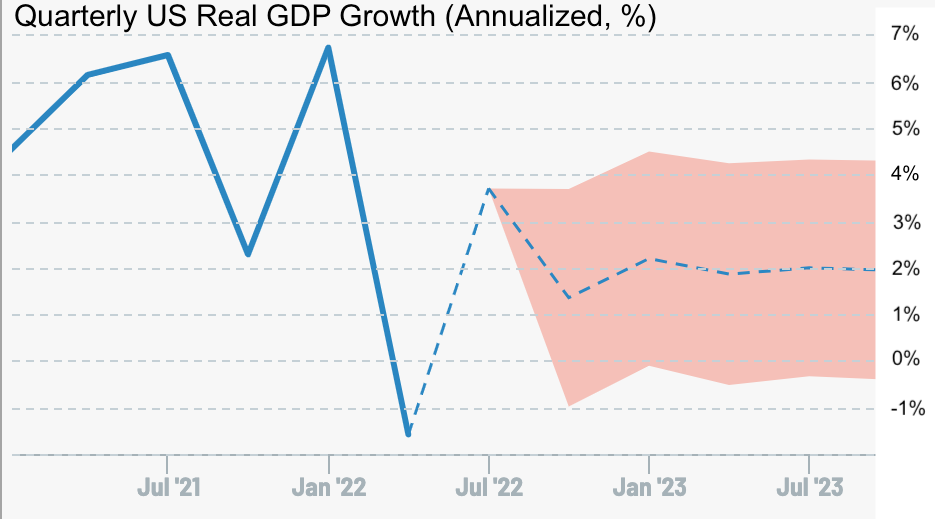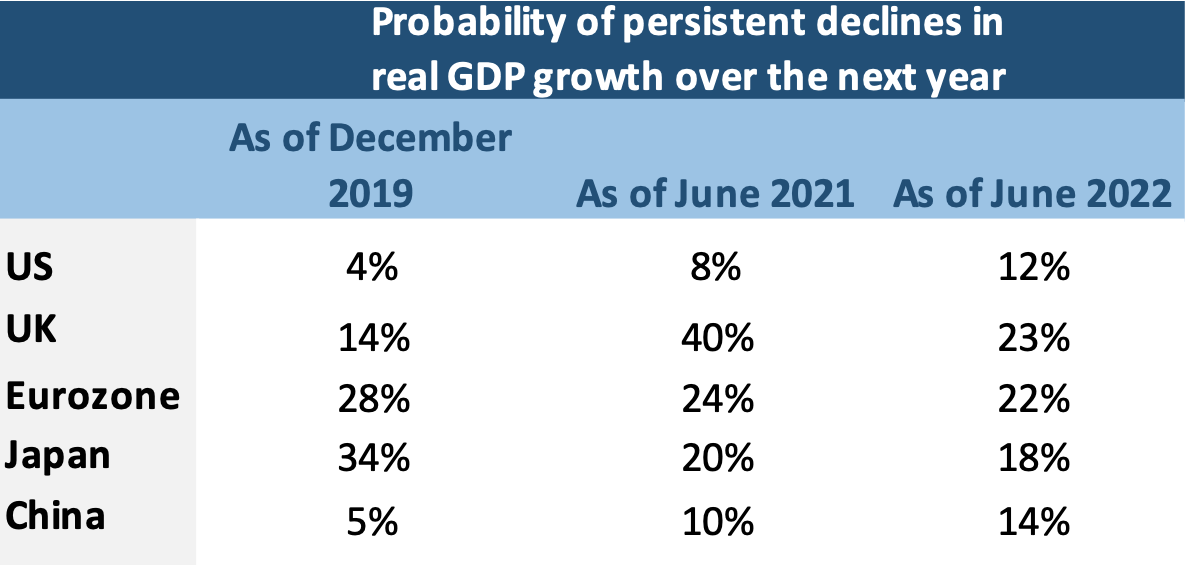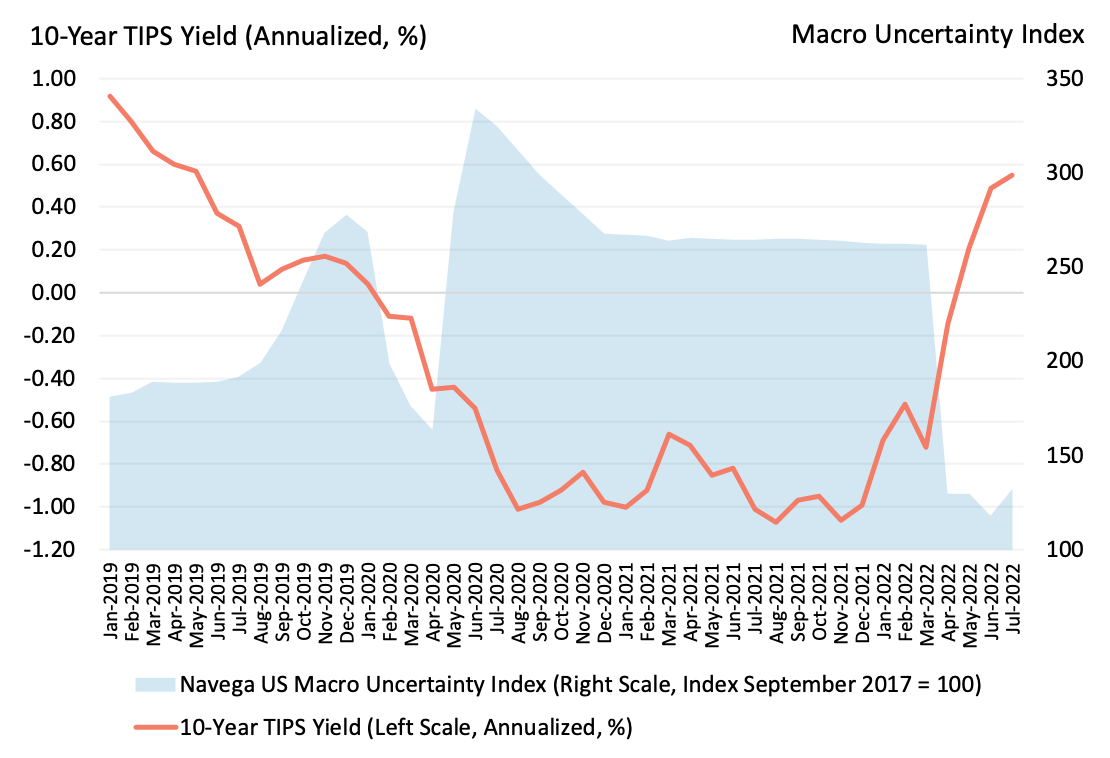
US real GDP decreased at the annualised rate of -0.9% during Q2 2022, according to the advanced estimate of the Bureau of Economic Analysis. This negative growth rate follows the annualised -1.6% contraction already experienced during Q1 2022, and is certainly not welcome in the current context of increases in interest rates, the war in Ukraine and high inflation. However, the key question for investors is whether this decline in real GDP will prove to be temporary, or should they be bracing for a more catastrophic scenario of persistent and larger declines? Recession fears , as quickly spread by many analysts and commentaries, as well as attributions of the YTD decline in stock markets to growth and inflation fears, are misplaced and do not serve investors, corporate leaders nor policy decision makers well. Instead, our models suggest that:
The risk of persistent, large negative shocks to real GDP growth over the next year have not changed significantly since June 2021, and that
Bond markets continue to price in a growth slowdown, consistent with perceptions of continued sluggish long-term growth trend.

Let's start by evaluating the risk of continued, large (above one standard deviation) negative shocks to US real GDP growth over the next year. Exhibit 1 portrays the recent evolution of quarterly US real GDP growth (solid blue line) and Navega models' baseline projections for the next 25 quarters (5 years) (dashed blue line). Note that our model projections are centred about our (model-based) prior for long-term growth of about 1.7%. Thus, it is reasonable to expect a significantly lower (although perhaps not negative) growth rate in Q1 2022 (and the subsequent year) following the high (above trend) growth rate of 6.9 % in Q4 2021.
A key benefit of our model is that it produces forecast distributions about the baseline projections. These distributions are summarised by the error band, depicted in Exhibit 1 (pink shaded area): the range of plausible outcomes within one standard deviation about the baseline projection, as implied by our models. In turn, our model forecast distributions allow to evaluate the probability of potential - transitory or persistent - shocks to real GDP growth. According to Exhibit 1, there is about a 10% chance of US real GDP growth experiencing a negative shock above one standard deviation (conditioned on the advanced BEA estimate for Q2 real GDP growth of -0.9%) during Q3. And there is a 12% chance of continued negative (above one standard deviation) shocks in the coming year (through June 2023) .

While these risks are not benign, it is important to assess how they compare to previous years. Exhibit 2 shows that the risk of persistent, large declines in US real GDP growth is currently elevated compared to pre-pandemic times (4%, as of December 2019). However it has not significantly changed compared to last year (8% as of June 2021). Note that this suggests that US bond (and equity) market changes over the past year have (for the most part) not been pricing-in potential and significant downside risks for growth expectations, per se. Interestingly, the Exhibit also shows a similar conclusion can be drawn for other major economies. In the case of China, the risk of persistent, above one standard deviation declines in real GDP growth increased significantly from 5%, pre-pandemic, to 10% post-pandemic (as of June 2021). It then increased, but not significantly so, to 15% as of June 2022. In the case of the UK, this risk was already high pre-pandemic (at 14% respectively). Post-pandemic, it jumped to 40% (as of June 2021). Since then, it has come down to 23%. As for the Eurozone, the risk of persistent large declines in real GDP growth was high pre-pandemic (at 28% as of December 2019) and has continued to remain high since then, at about 24% as of June 2021, and 22% more recently. Finally, in the case of Japan, although still elevated, this risk has been declining from 34% in pre-pandemic times to about 20% in June 2021 and 18% as of last month.
Thus, most likely, bond (and equity) markets are not pricing in an increase in persistent, large negative shocks to real GDP growth. And as discussed in our previous paper, they are not pricing in an increase in inflation expectations either. Instead, according to our models, bond markets pricing is consistent with a decline in uncertainty about a sluggish long-term growth trend (or, more consensus that long-term growth will be sluggish). This point is illustrated in Exhibit 3 and Exhibit 4.

Exhibit 3 depicts the recent evolution (since 2019) of the long-term US real GDP growth implied by our models, along with its drivers. These are the long-term (real) growth in the labor force and total factor productivity (TFP) . According to the Exhibit, labor force growth has been recovering on trend on a continuous basis since January 2021 . While long-term TFP growth has remained sluggish, on average at about 0.8% (slightly above pre-pandemic trend but well below its 1.5% pre-2008 GFC average), there were no signs of relative deterioration . In turn, these trends imply a continuation of sluggish long-term real economic growth.
Exhibit 4 turns to the evolution of 10-year US TIPS yields and its link to macro uncertainty. After entering negative territory at the start of the pandemic, the 10-year TIPS yield bottomed at -100bps from August 2020 through December 2021. Since January 2022, real yields have been increasing on trend, averaging 55bps in July 2022 - a 120bps increase, YTD.

Our macro-based models help understand the fundamental long-term drivers of this increase in real yields. According to our models, increases (declines) in real yields, on trend, are driven by the combination of increases (declines) in expectations of long-term growth and declines (increases) in growth uncertainty. The intuition is that investors demand insurance against shocks to real economic growth in the form of government bonds. Assuming no change in long-term growth prospects (according to Exhibit 3), Exhibit 4 shows that this increase in real yields is indeed consistent with markets' pricing of a decline in uncertainty about long-term real GDP growth, from its acutely high level induced by the pandemic. More precisely, our (monthly updated) macro uncertainty index decreased from 263 to 132, a nearly 50% decline. This decline in macro uncertainty (and the corresponding increase in real yields) is also consistent with the continuation of anaemic real GDP growth, driven by sluggish TFP growth and shy improvements in labor force growth, as portrayed by Exhibit 3.
These trends in risk of persistent, large negative US real GDP growth shocks (nearly unchanged from previous year), macro uncertainty, and long-term growth are consistent with a slowdown in growth. The slowdown in real growth can be viewed as a supply-side driven adjustment after a demand-side driven expansion post-Covid. These points are further supported by the recent changes in major indicators of economic activity, as shown in Exhibit 5.

According to the Exhibit, the monthly change in retail sales from previous year dropped from 17.7% in February to 7.1% in March. Since then, it has been stable at around 8%, a rate that still remains higher than its historical average of 4.8%. The high growth rate in retail sales that prevailed through 2021 reflected the surge in economic activity and demand in the US, as the country recovered from the pandemic. The recent slowdown in retail sales growth reflects demand-side adjustments to supply-side restrictions, as portrayed by a relatively stable, about average capacity utilisation rate and year-on-year growth in industrial production. As for unemployment, it also remained stable, below its historical average.
Taken together, bond (and equity) market pricing, recent changes in timely macro indicators, our model implied risks of persistent negative shocks to real GDP growth, long-term real GDP growth and growth uncertainty all point to a slowdown in real economic activity, and market consensus about continued sluggish long-term real growth. Given the current geopolitical context and the persistence of global supply-side frictions, investors are well advised to watch for any continued deteriorations in timely macro indicators (and alternative measures) and trace their impact on long-term real economic growth and growth uncertainty - and in turn, long-term market returns and allocation strategies.
This document is for informational purposes only. This document is intended exclusively for the person to whom it has been delivered, and may not be reproduced or redistributed to any other person without the prior written consent of Navega Strategies LLC (“Navega”). The information contained herein is based on Nageva’s proprietary research analytics of data obtained from third party statistical services, company reports or communications, publicly available information, or other sources, believed to be reliable. However, Navega has not verified this information, and we make no representations whatsoever as to its accuracy or completeness. Navega does not intend to provide investment advice through this document. This document is in no way an offer to sell or a solicitation of an offer to buy any securities. Investing in securities involves risk of loss, including a loss of principal, that clients should be prepared to bear. Past performance is not indicative of future results, which may vary materially. While this summary highlights important data, it does not purport to capture all dimensions of risk. The methodology used to aggregate and analyze data may be adjusted periodically. The results of previous analyses may differ as a result of those adjustments. Navega has made assumptions that it deems reasonable and used the best information available in producing any calculations herein. Statements that are nonfactual in nature, including opinions, projections and estimates, assume certain economic conditions and industry developments and constitute only current opinions that could be incorrect and are subject to change without notice. All information provided herein is as of the delivery date the document (unless otherwise specified) and is subject to modification, change or supplement in the sole discretion of Navega without notice to you. This information is neither complete nor exact and is provided solely as reference material with respect to the services offered by Navega. Information throughout this document, whether stock quotes, charts, articles, or any other statement or statements regarding market or other financial information, is obtained from sources which we and our suppliers believe reliable, but we do not warrant or guarantee the timeliness or accuracy of this information. The information presented here has not been personalized, and is not based on the financial circumstances of the recipient. This information may not be applicable to your particular financial needs, and should not, by itself, be used to make determinations regarding the purchase or sale of securities, or other investment decisions.
The model performance information presented is based on the application of Navega’s factor analysis, backtested against actual historical data. “Backtesting” is a process of objectively simulating historical performance information by applying a set of rules backward in time. The results of the application of Navega’s model do not reflect actual performance or actual historical data. Such models are prepared with the full benefit of hindsight, and it is not likely that similar results could be achieved in the future.
The model portfolios were constructed by Navega with the benefit of hindsight to illustrate certain performance metrics. The performance shown was not actually achieved by any investor. The investments in these hypothetical portfolios were selected with the full benefit of hindsight, after performance over the period shown was known. It is not likely that similar results could not be achieved in the future. The hypothetical portfolios presented here are purely illustrative, and representative only of a small sample of possible scenarios.
The projections shown do not represent actual performance, and are based on assumptions which may not occur. It is possible that the markets will perform better or worse than shown in the projections, the actual results of an investor who invests in the manner these projections suggest will be better or worse than the projections, and an investor may lose money by relying on these projections.